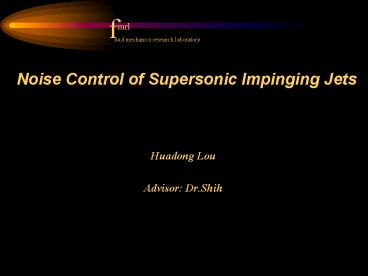Huadong Lou PowerPoint PPT Presentation
1 / 34
Title: Huadong Lou
1
Noise Control of Supersonic Impinging Jets
- Huadong Lou
- Advisor Dr.Shih
2
Contents
- Motivation
- Mechanism
- The progress in the past half century.
- What we done
- Future work
3
Motivation
Flow schematic for a twin jet STOVL aircraft in
hover
4
Motivation
B1-B
F-15
Sonic fatigue failure
5
Motivation
Screech tone
Broadband shock noise
Mixing noise
6
Mechanism
7
Mechanism
P
x
Schematic of the shock-vortex interaction
8
Feedback loop
Mechanism
Upstream propagating acoustic waves
Downstream- traveling instability structures
9
Mechanism
10
Mechanism
11
Mechanism
Feedback loop
- Downstream propagating instability wave
- The interaction of vortical disturbance with
shock-cell structure in the jet - The back propagation of the acoustic disturbance
to the nozzle lip - The conversion of acoustic disturbance into
instability wave at the nozzle lip
12
Goal
- To actively and efficiently control the jet
behavior by - disrupting the feedback loop.
- Reduce Tones, OASPL and other related adverse
effects
13
Prior Attempts at Feedback Control
Suppression the Screech tone
- Hammit Using reflect plate, stabilize the
screech tones - Tanna Using the tab combination of the sound
absorbing materials. - Norum Proved the effectiveness of the plates
- Kozlowski, Nagel et al. Non-intrusive tabs
simulating full-scale lip irregularities - Ahuja et al. Using tabs directly intruding into
jet flow
14
Prior Attempts at Feedback Control
- Karamcheti et al. (1969) Edge tone suppression
using baffles/plates - Sheplak Spina (1994) Impinging tone
suppression via coflow - Shih et al. (1999) Screech tone suppression
using counterflow - Elavarasan et al. (1999) Impinging tone
suppression via baffles
15
Present Approach
- Use supersonic microjets to disrupt the coherent
flow-acoustic coupling. - High momentum, small, low mass flow,
relatively simple, can be actively manipulated to
provide on-demand control.
16
Experimental Details
DIAGNOSTICS Unsteady Pressures Ground Lift
Planes Acoustic Flow visualization Shadowgraph
Planar Laser Scattering (PLS) Mean
Pressures Ground Lift Planes PIV
Parametric Space NPR (Po/Pa) 3.7 5.0 h/d
2.0 - free Nozzle Mach 1 1.5 Microjet Press.
80 - 120 psi
17
Test Geometry Hardware
Pressure taps
Microjets (400?m)
Kulites
Primary Nozzle
Test Conditions NPR 2.5, 3.7 5
h/d 2 - 10
Lift Plate
18
Test Model and Facility
Lift plate
Ground plate
19
Test Model and Facility
20
Lift plate
CD nozzle
Ground plane
21
Unsteady Pressure Spectra
NPR 3.7 h/d4.0 No Control
NPR 5.0 h/d3.5 No Control
Unsteady Pressure Loads Ground Plane 185-195
dB Lift Plate 165-175 dB
22
Schematic shadowgraph arrangement
23
Uncontrolled Impinging Jet Flow Instantaneous
Shadowgraphs
Sonic Nozzle, No Lift Plate NPR 5, h/d 3
Mach 1.5 C-D Nozzle, Lift Plate NPR 3.7, h/d 4
24
Planar Laser Scattering (PLS)
Nozzle
Laser sheet
Laser
Jet flowfield
Camera
25
PLS Images, Averaged
NPR5 h/D4
No Control
With Control
26
Surface Mean Pressure measurements
27
Microjet Details
400 mm Jet
- Microjet diameter 400 ?m
- Operating pressure 80- 120 psi
- Mass flow (total) 0.4 0.7 of main jet
- Operating gas Nitrogen/Air
- Microjet inclination angle 200
28
Effect of Microjet Control
NPR 5, h/d3.5
29
Effect of Microjet Control
NPR 3.7, h/d3.5
30
Effect of Microjet Control Shadowgraphs NPR
3.7, h/d 4.5
Large-scale Structures
With Control
Without Control
31
Effect of Microjet Control
20, 100 psi, 16 microjets
NPR 5.0, h/d3.5 Lift Plate
NPR 3.7, h/d 4 Ground Plane
32
Lift Loss
NPR3.7
33
Effect of Microjet Control
20, 100 psi, 16 microjets
NPR 5 - Ground Plane
NPR 3.7- Lift Plate
34
Future Work
- Characterize the velocity and vorticity field
with and without microjets using PIV - Identify relevant control parameters/knobs for
effective control - E.g. mass and momentum flux ratio, number
separation of microjets, scaling. - Explore on-line monitoring and adaptive
manipulation of microjets for optimal control. - Pressure, pulsing, location, number and
orientation .

